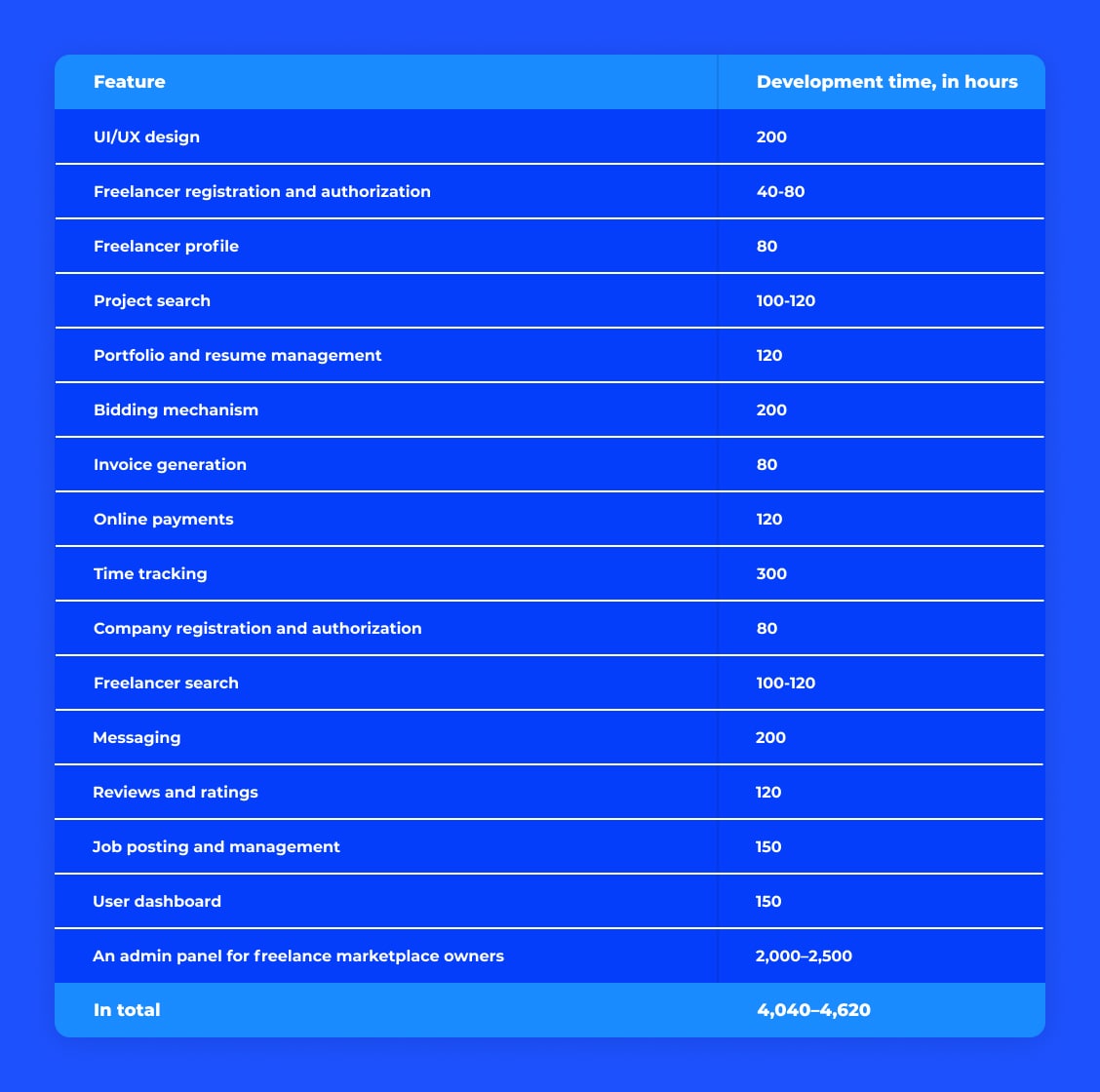The functionality of a freelance website like Upwork
Freelance marketplace features for remote contractors
1.
Registration and authorization
Sign up/in is an essential feature of an online marketplace like
Upwork that enables users to create personal profiles. An important
rule is to make registration and authorization as simple as
possible. For example, you can let professionals connect their
profiles with Facebook or LinkedIn accounts.
Before adding a new user to the system, it is crucial to verify
identity and qualification by requiring them to share documents,
portfolios, certificates, and social network links. This will help
you protect businesses from fraud and increase trust in a
marketplace.
Time: 40-80 hours
2.
Freelancer profile
A freelancer profile generally contains a photo of a specialist and
basic information such as name and surname, services rendered,
location, contacts, links to social network profiles, work history.
A profile should also describe skills possessed and languages known
by a remote professional. In addition, it should display rating
scores and reviews to facilitate the hiring process for employees
while raising the credibility of your freelance marketplace.
Time: 80 hours
3.
Project search
Task search is another key feature of a freelance website like
Upwork. Specialists should be able to look for jobs using various
filters, for example, type of work, category, start date, and
salary. By allowing remote contractors to search for projects by
their skills, you will significantly boost their engagement.
Time: 100-120 hours
4.
Portfolio and resume management
When building an online freelance marketplace, it is important to
enable specialists to create portfolios: write project descriptions,
upload images, attach resumes and other documents that demonstrate
experience, as well as edit information.
Time: 120 hours
5.
Bidding mechanism
Independent professionals should have the possibility to reply to
job offerings and set the cost at which they are ready to perform
the necessary tasks. Employers, in their turn, will review applicant
responses and choose the most suitable option.
Time: 200 hours
6.
Invoice generation
After the project is completed and approved by the client, an online
freelance marketplace platform has to generate an invoice while
automatically calculating the cost. This will remove contractor
headaches associated with bureaucracy issues while increasing trust
due to the lack of human errors.
Time: 80 hours
7.
Online payments
When creating a freelance website like Upwork, it is essential to
provide online payments. By integrating a gateway service—an analog
of a third-party virtual terminal that serves for transaction
processing—marketplace developers deliver a variety of payment
methods.
For instance, Stripe provides money transfers via PayPal, Venmo,
cards (i.e., Visa, Amex, Mastercard), digital wallets (Google Pay,
Apple Pay), and bank directs (i.e., SOFORT, iDEAL, eps, GiroPay, and
Afterpay).
In order to protect against fraud and other security threats,
payment gateways generally include features such as 3D Secure, CVV
(card verification code check), and AVS (Address Verification
System).
Time: 120 hours
8.
Time tracking
With the time tracking functionality, you will enable professionals
to indicate how much time they have spent on each task and change
its status, as well as leave comments. As a consequence, businesses
will be able to monitor project progress.
If you decide to add this feature, it is possible to integrate an
online freelance marketplace with a specialized third-party service,
for example, Jira REST API.
Time: 300 hours
Freelance marketplace features for employers
1.
Company registration and authorization
Just like remote contractors, organizations should have the
possibility to register on a digital freelance platform. When
building a website like Upwork, it is reasonable to suggest
employers sign up when viewing services and candidate profiles but
this should not be obligatory.
Otherwise, the satisfaction rate may be reduced and, consequently,
the number of registered companies will be lower. We recommend that
you require organizations to register only before publishing a job
announcement.
Time: 80 hours
2.
Company profile
An employer profile generally contains information such as
organization name, address, logo, sector, contact details, and
website URL. In addition, the profile should include the company’s
description and social media links.
Time: 80 hours
3.
Freelancer search
Contractor search is among the key features of an online freelance
marketplace platform. When making a website like Upwork, you should
provide as many filters (e.g., skills, budget, delivery time,
location, experience) and categories (i.e., translation,
programming, graphic design, content writing) as possible to
automate the process of seeking independent professionals.
Furthermore, it is crucial to enable search by keywords.
Time: 100-120 hours
4.
Messaging
Employers and specialists need to interact before and throughout the
project to discuss task details. To deliver this functionality of a
freelance website like Upwork, software engineers can create private
and group chats while ensuring data security.
Additionally, it is reasonable to integrate a marketplace platform
with a messenger, so that your employees can communicate with
freelancers via audio and video calls. For this purpose, software
developers can use a third-party service, for instance, Slack API.
Time: 200 hours
5.
Reviews and ratings
The review and rating system is another vital feature of a freelance
marketplace as it provides businesses and institutions with a
trusted source of valuable feedback. Independent professionals, in
their turn, will be motivated to deliver the highest quality.
However, only registered companies that have actually turned to
contractors should be able to rate rendered services and write
testimonials.
Time: 120 hours
6.
Job posting and management
When building a freelance marketplace platform like Upwork, it is
important to provide organizations with the possibility to post
projects, including description, candidate responsibilities,
requirements, and delivery time.
Time: 150 hours
7.
User dashboard
With a user dashboard, employers can view project history and
information about contracts, as well as manage account and job
details. Furthermore, you can enable organizations to view lists of
submissions sent by freelancers for each project.
Time: 150 hours
An admin panel for freelance marketplace owners
Serving as a web application, an admin panel allows the owners of a
freelance marketplace platform to manage search categories and
subcategories, set up and charge commissions, track payments, as
well as view earnings reports.
What’s more, it is essential to provide the possibility to add new
companies and professionals to the system. For the purpose of
improving security, you should implement role-based data access
control. Thanks to this feature, you will be able to assign
role-based access permissions for employees and monitor who
introduced which changes.
Time: 2000–2500 hours



